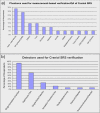Current status of cranial stereotactic radiosurgery in the UK
- PMID: 26689091
- PMCID: PMC4985193
- DOI: 10.1259/bjr.20150452
Current status of cranial stereotactic radiosurgery in the UK
Abstract
Objective: To investigate and benchmark the current clinical and dosimetric practices in stereotactic radiosurgery (SRS) in the UK.
Methods: A detailed questionnaire was sent to 70 radiotherapy centres in the UK. 97% (68/70) of centres replied between June and December 2014.
Results: 21 centres stated that they are practising SRS, and a further 12 centres plan to start SRS by the end of 2016. The most commonly treated indications are brain metastases and acoustic neuromas. A large range of prescription isodoses that range from 45% to 100% between different radiotherapy centres was seen. Ionization chambers and solid-water phantoms are used by the majority of centres for patient-specific quality assurance, and thermoplastic masks for patient immobilization are more commonly used than fixed stereotactic frames. The majority of centres perform orthogonal kilovoltage X-rays for localization before and during delivery. The acceptable setup accuracy reported ranges from 0.1 to 2 mm with a mean of 0.8 mm.
Conclusion: SRS has been increasing in use in the UK and will continue to increase in the next 2 years. There is no current consensus between SRS centres as a whole, or even between SRS centres with the same equipment, on the practices followed. This indicates the need for benchmarking and standardization in SRS practices within the UK.
Advances in knowledge: This article outlines the current practices in SRS and provides a benchmark for reference and comparison with future research in this technique.
Figures








Similar articles
-
Biological implications of whole-brain radiotherapy versus stereotactic radiosurgery of multiple brain metastases.J Neurosurg. 2014 Dec;121 Suppl:60-8. doi: 10.3171/2014.7.GKS141229. J Neurosurg. 2014. PMID: 25434938
-
Radiosurgery alone for 5 or more brain metastases: expert opinion survey.J Neurosurg. 2010 Dec;113 Suppl:84-9. doi: 10.3171/2010.8.GKS10999. J Neurosurg. 2010. PMID: 21121790
-
Treatment trends for patients with brain metastases: Does practice reflect the data?Cancer. 2017 Jun 15;123(12):2274-2282. doi: 10.1002/cncr.30607. Epub 2017 Feb 8. Cancer. 2017. PMID: 28178376
-
Stereotactic radiosurgery for multiple brain metastases.Expert Rev Anticancer Ther. 2014 Oct;14(10):1153-72. doi: 10.1586/14737140.2014.940325. Epub 2014 Jul 18. Expert Rev Anticancer Ther. 2014. PMID: 25034143 Review.
-
UK intussusception audit: a national survey of practice and audit of reduction rates.Clin Radiol. 2014 Apr;69(4):344-9. doi: 10.1016/j.crad.2013.10.024. Epub 2013 Dec 17. Clin Radiol. 2014. PMID: 24360511 Review.
Cited by
-
Technological quality requirements for stereotactic radiotherapy : Expert review group consensus from the DGMP Working Group for Physics and Technology in Stereotactic Radiotherapy.Strahlenther Onkol. 2020 May;196(5):421-443. doi: 10.1007/s00066-020-01583-2. Epub 2020 Mar 24. Strahlenther Onkol. 2020. PMID: 32211939 Free PMC article. Review.
-
Study on the application of 3D printing head film fixation technology in cranial radiotherapy.J Cancer. 2023 Apr 9;14(6):981-988. doi: 10.7150/jca.82909. eCollection 2023. J Cancer. 2023. PMID: 37151399 Free PMC article.
-
Adaptation and validation of a commercial head phantom for cranial radiosurgery dosimetry end-to-end audit.Br J Radiol. 2017 Jun;90(1074):20170053. doi: 10.1259/bjr.20170053. Epub 2017 May 25. Br J Radiol. 2017. PMID: 28452563 Free PMC article.
-
The impact of target positioning error and tumor size on radiobiological parameters in robotic stereotactic radiosurgery for metastatic brain tumors.Radiol Phys Technol. 2022 Jun;15(2):135-146. doi: 10.1007/s12194-022-00655-5. Epub 2022 Mar 7. Radiol Phys Technol. 2022. PMID: 35257314
-
3D-Printed masks as a new approach for immobilization in radiotherapy - a study of positioning accuracy.Oncotarget. 2018 Jan 8;9(5):6490-6498. doi: 10.18632/oncotarget.24032. eCollection 2018 Jan 19. Oncotarget. 2018. PMID: 29464087 Free PMC article.
References
-
- Sheehan JP, Yen CP, Lee CC, Loeffler JS. Cranial stereotactic radiosurgery: current status of the initial paradigm shifter. J Clin Oncol 2014; 32: 1–11. doi: 10.1200/JCO.2013.53.7365. Available from: http://jco.ascopubs.org/content/32/26/2836.short - DOI - PMC - PubMed
-
- Franzini A, Marchetti M, Brait L, Milanesi I, Messina G, Forapani E, et al. . Deep brain stimulation and frameless stereotactic radiosurgery in the treatment of bilateral parkinsonian tremor: target selection and case report of two patients. Acta Neurochir (Wien) 2011; 153: 1069–75. doi: 10.1007/s00701-011-0962-0. Available from: http://link.springer.com/article/10.1007/s00701-011-0962-0 - DOI - DOI - PubMed
-
- Combs SE, Thilmann C, Debus J, Schulz-Ertner D. Long-term outcome of stereotactic radiosurgery (SRS) in patients with acoustic neuromas. Int J Radiat Oncol Biol Phys 2006; 64: 1341–7. doi: 10.1016/j.ijrobp.2005.10.024. Available from: http://www.sciencedirect.com/science/article/pii/S0360301605028695 - DOI - PubMed
-
- Walton L, Bomford CK, Ramsden D. The Sheffield stereotactic radiosurgery unit: physical characteristics and principles of operation. Br J Radiol 1987; 60: 897–906. Available from: http://www.birpublications.org/doi/abs/10.1259/0007-1285-60-717-897 - DOI - PubMed
Publication types
MeSH terms
LinkOut - more resources
Full Text Sources
Other Literature Sources

